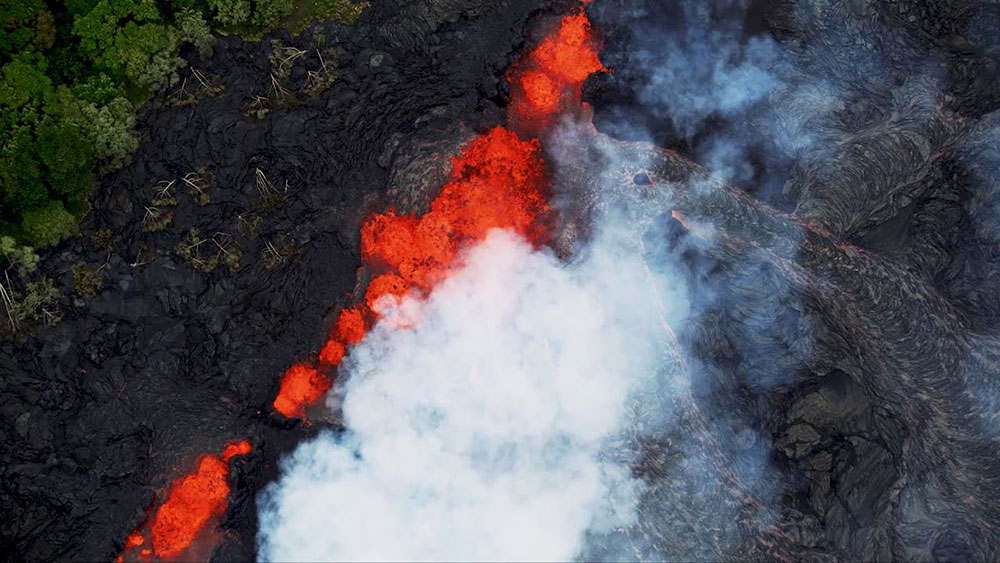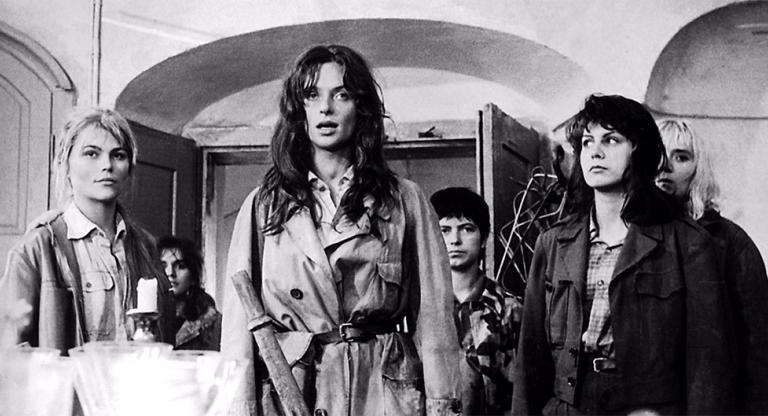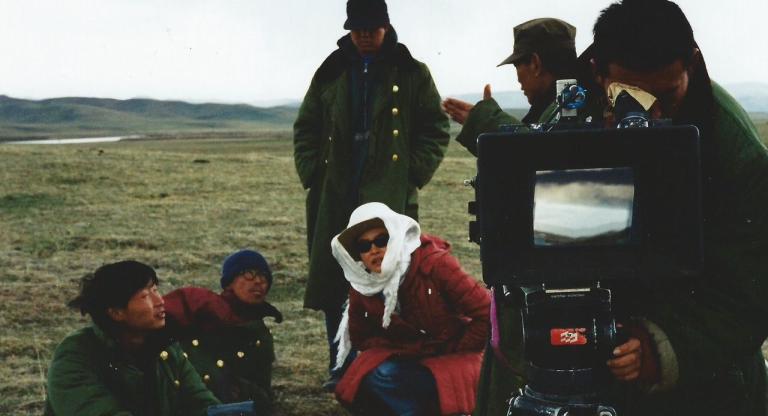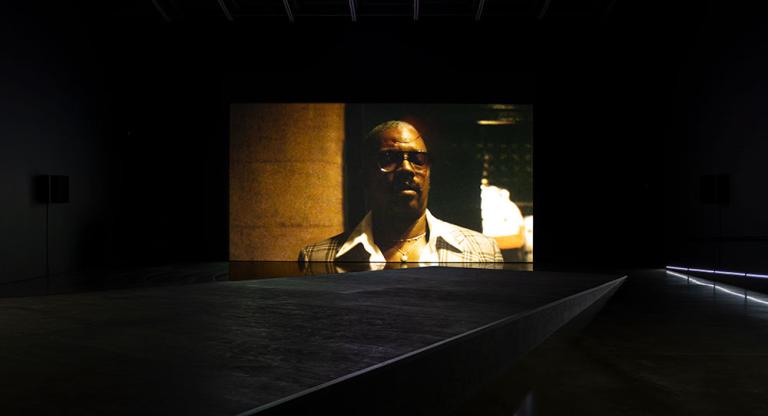Growing up in Honolulu, Hawaiʻi has given me fond memories of grade-school field trips to the Bishop Museum’s Mamiya Science Adventure Center. One of its main attractions is a long tunnel, resembling a lava tube, that snakes into darkness under a hollow volcano containing lava-related exhibits. Upon entering, visitors are transported to a totally different environment: a neon rainforest gleaming under black light, populated by child-crafted artworks that animate the Kumulipo, a Hawaiian creation chant. It’s a trippy, entrancing experience, one that approximates what it feels like to watch Fern Silva’s debut feature, Rock Bottom Riser (2022).
Like Silva’s previous shorts, Rock Bottom Riser is a collage of interrelated topics: the contemporary revival of Polynesian navigation, active lava flows on the Big Island of Hawaiʻi, the search for extraterrestrial life, the casting of Dwayne “The Rock” Johnson as Kamehameha I in a Hollywood biopic, and most significantly, the planned construction of the Thirty Meter Telescope (TMT) on the summit of Mauna Kea. The mauna (mountain) is managed by the University of Hawaiʻi and houses thirteen working telescopes. It is sacred to Kānaka Maoli (Native Hawaiians) and prized by astronomers worldwide for its unmatched viewing conditions. Settler-colonial claims to its use have cast Kānaka who oppose the TMT’s construction as antagonistic to astronomy and anti-scientific. But as scholar-activist Bryan Kamaoli Kuwada asserts, Hawaiians are “modern, innovative, future-looking native peoples” who resist the continued desecration of their lands and waters in the name of “progress” under US occupation.
As a film partially about how mountains and volcanoes have been represented and valued, Rock Bottom Riser might be seen as a corrective to films like Sara Dosa’s Sundance-winning Fire of Love (2022), which, as critic Abby Sun points out, “completely avoids any mention that Western scientists and volcanologists have historically discounted Indigenous knowledge.” Against this erasure, Silva’s film articulates a kind of hybrid cosmology that might emerge from viewing the earth and the stars through a lens informed by the complexities of cultural contact.
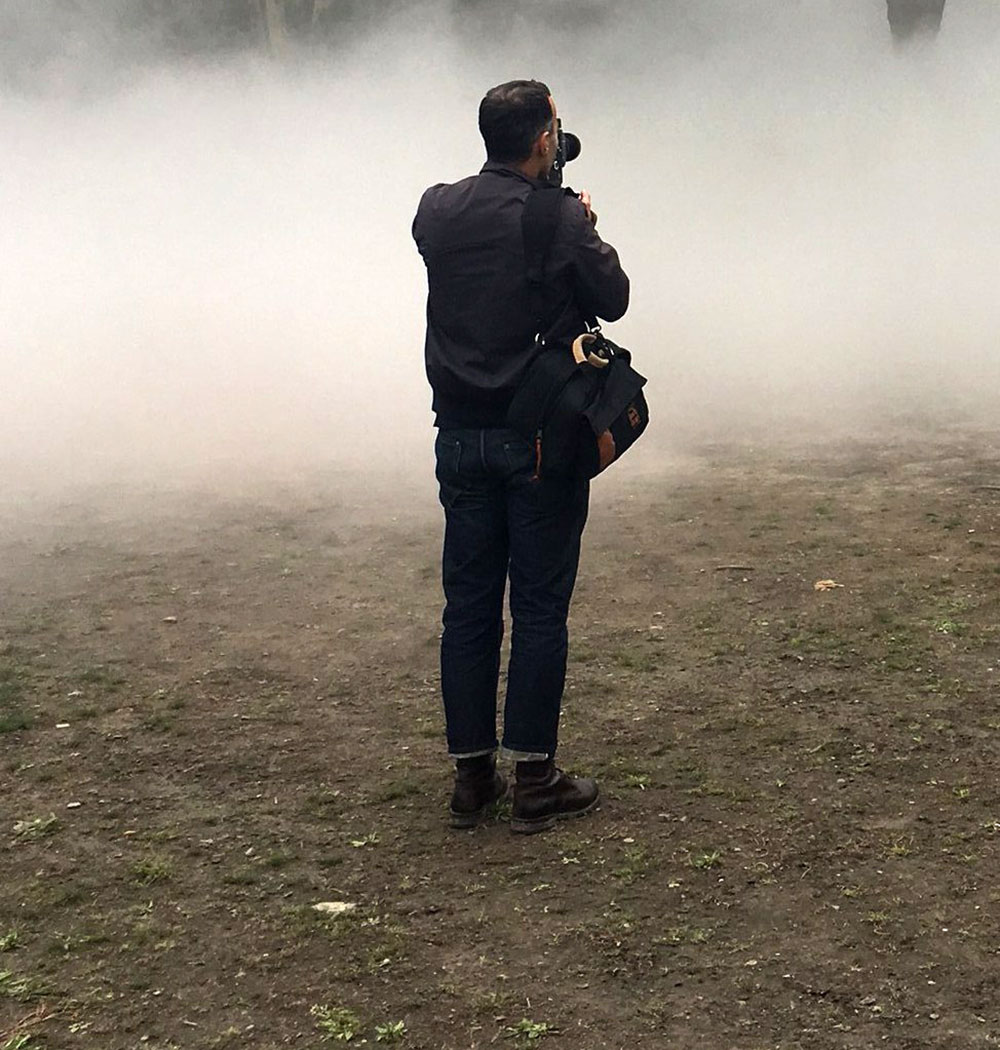
Emerson Goo: First of all, is Rock Bottom Riser ethnographic? Counter-ethnographic? Something else entirely?
Fern Silva: I’m not a trained ethnographer, so I don’t think it’s technically ethnographic. I am interested in scrutinizing/dissecting ethnographic/documentary strategies and formulas in cinema. I understand how much of an impact [ethnography has] made on our perception of one another and the earth throughout history. I do think about that while making films in hopes of also making the audience aware of that. I try to avoid coining a term or labeling; I don’t want to feel like I’m making a product. It’s more important to share thoughts, especially now in our late stages of capitalism where branding is a bit forced, to say the least. With that said, nowadays anything that’s labeled as a ’90s thriller. . . I’m all over it, can’t get enough.
EG: I must admit that I was initially skeptical of your film. There are many documentaries that brand themselves as “sensory/experimental ethnography” and replicate the worst tendencies of the films they intend to differentiate themselves from—except instead of using “savage” cultures as a measuring stick to investigate the human, they use them to explore theories of the posthuman and postcolonial while ignoring the problems their subjects face. I think your film is mindful of these pitfalls, but I’m curious to know if you were thinking about these issues.
FS: I also started from a place of skepticism, of both myself and the subject matter. This was constant throughout the whole process. I understand what you mean about some of the films you’re talking about: how they’re made, who’s making them, their resources, lineage, control, perspective, shelter, pedigree, etc. My film has been an ever-growing and ever-changing learning process. I approached the project with a concern for cultural and environmental preservation, human intervention, and the pressures of Americanization. This I’m sure comes from my own upbringing, the values that were instilled in me navigating cultural identity in America as a kid.
The benefit of working on Rock Bottom Riser for years was that I was able to listen and learn about so many viewpoints from so many people, and understand nuances and different perspectives among haole and Kānaka Maoli. Although my entry point was through what activists were expressing, I thought it was important to think of the film as a point of inquiry that would raise questions in hopes of activating viewers to do their own research on Hawaiʻi’s history of discovery, exploration, and occupation.
EG: I’d love to know how you became interested in the topics covered in the film. What was the research process like?
FS: After reading about Mauna Kea being selected as the construction ground for the TMT back in 2009 and the opposition [to its construction], I was brought back to my interest in ancient Polynesian voyaging as a kid. I was obsessed with navigation and exploration, and knew that what the Polynesians were able to accomplish was (and still is) the greatest feat in the history of humankind. I always thought of the ancient Polynesians as an advanced civilization and some of the world’s greatest astronomers, arriving in Hawaiʻi at least 1,700 years ago—let alone the rest of the Pacific over 6,000 years ago—on canoes, skillfully, without navigational instruments, long before the Europeans. That certainly guided me while navigating my own thoughts on potentially making a film.
Conversations with a friend and frequent collaborator who was spending a lot of time on the Big Island visiting family really put the wheels in motion to make the film. I spent years listening to everyone from activists, cultural practitioners, astronomers, geologists, preservationists, volcanologists, navigators, farmers, teachers, actors, etc. which really forced the structure of the film as I tried to combine multiple levels of meaning. Nainoa [Thompson, president of the Polynesian Voyaging Society] continues to be such an important voice and it’s incredible to have heard him and Kalepa [Baybayan] talk about their interactions with Mau Piailug while he was training them in traditional, non-instrument wayfinding.
EG: I know you’re from Portugal, and Portuguese immigration to Hawaiʻi during the plantation era is a big part of our history. Did that play into your research?
FS: The Portuguese connection was definitely a part of it, but it became a lost cause as I had no way of finding out which island [my relatives] would’ve been on. Once I found the list of Portuguese that were working in the [plantation] fields, I really bottomed out. There were so many Silvas and at least ten other Fernando Silvas. The Portuguese Culture Center in Hilo was super helpful, but the more I thought about it, [I realized] it would be its own film. Through that, though, I learned a lot about John Kameaaloha Almeida’s life story and impact, and Hawaiian hānai [informal adoption and foster parenting] traditions. His father abandoned him and went back to Portugal. . .talk about "savage" cultures.
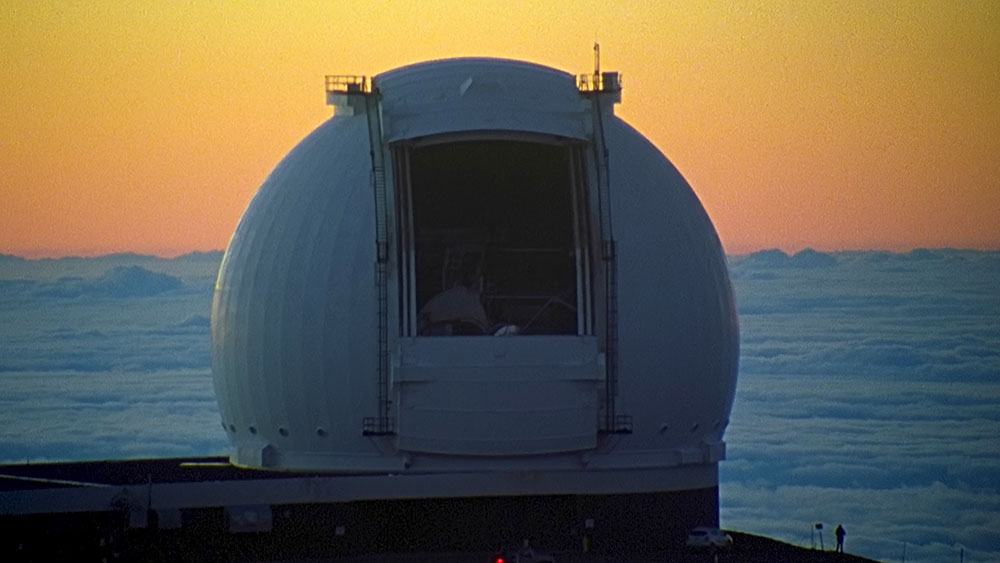
EG: You shot mostly on the Big Island, capturing the active lava flows there. In both content and practice, this reminds me of the Volcano School of artists that painted Kīlauea and Mauna Loa, and you do show some of their paintings. What went into crafting the look of the volcanoes and lava in the film?
FS: I did have the Volcano School in mind. Those paintings are incredibly romanticized, fictionalized caricatures. Some of them were later used for the covers of sci-fi novels. That was the impulse for laying them under the voice of the SETI astronomer talking about traveling to Alpha Centauri, making this connection between potential future space migration and settlers from the past. With that in mind, and juxtaposing the aesthetic decisions of the Volcano School painters, I wanted to shoot lava in its various forms, with longer takes, in a visceral way, showing the earth’s raw force and reminding us that we are not in control.
EG: What practical and logistical challenges did you face on location?
The relentless sound over the images of the pāhoehoe and ʻaʻā was recorded while I was shooting those images. That’s what it actually sounds like, crackling, popping, and shrieking glass. I went out there multiple times, usually with one other person. It was a four-mile bike ride with a trailer/baby pod filled with equipment, and then at least an hour and a half hike each way on pretty intense terrain, sharp lava rock with cracks that sometimes slid down several feet, all in the dark. I’d often come home with bloody hands and shins. It’s basically sharp as glass, hence the sound. There were certainly a couple times where the rubber on my shoes and tripod sticks melted.
As for the aerial photography, I went up in a helicopter with [the pilot] David Okita, who [has done] all sorts of work for the fire department and USGS and other photographers for decades. Interestingly enough, he happened to be the partner of the Volcano School paintings’ curator/archivist, who I was working with as well.
EG: You also tackle painting in Ride Like Lightning, Crash Like Thunder (2017), which deals with upstate New York and the Hudson River School. In both films, you’re thinking of landscape painting as a way of communicating with the future. Are you making links between that and the SETI projects that are trying to figure out what a message from extraterrestrials would look like? And maybe also the Voyager Golden Record, which is used in the soundtrack?
FS: You know, I think of those paintings as more of an erasure. There’s no doubt that they’re beautiful and skillfully rendered, and there’s a reason Kīlauea and the Hudson River attracted so many artists—because of how majestic the landscape is. But they are painted in a particular light, that of God, and devoid of colonial atrocities. I can’t help but always think of that when I’m shooting the landscape in America. There’s an incredible absurdity in all of it and how it’s been commodified. I would hope that my films do question all of those things for a future audience to contemplate and/or decode.
The Golden Record was such a beautiful gesture, and the use of it in my film is from a remix of it by extraterrestrials who intercepted the record back in 2005. That’s all I’m allowed to say.
EG: The contrast between 16mm and digital imagery in the film is prominent, but to me it’s not so much about looking at film formats, but the concept of grain and resolution itself. Astronomers are so focused on overcoming the atmosphere, getting the clearest, most unobstructed view, going to the tops of mountains to do so, but at the same time they’re often working at the limit of what optics can actually resolve visually.
FS: Absolutely, which is why they also make infrared observations, reading spectral features of any given exoplanet. The actual illustrations we see based on data are just an educated guess, but we store them in our memory as if they’re actual pictures. For a recent example, who’s to say the yellow/red/orange ring of the Event Horizon black hole is even that color? What’s so fascinating to me about film is that it’s such an inaccurate tool for capturing the stars in the sky, but at the same time, the photochemical process couldn’t be more cosmic based on common theories. Once photons hit silver halide crystals on the surface of a piece of film, there are thousands of little explosions that eventually form an image, a reflection of our world in the past that materializes into a piece of evidence.
EG: To that end, I was intrigued by the almost invisible figure in the film, that warps the light around it as it moves. Where did that come from?
FS: I think that this invisible image blending in with the landscape represents the empirical evidence that a symbiotic connection to nature is attainable, while reminding us of the destruction that colonial powers impose on sovereignty.
EG: I really enjoyed your incorporation of actor Moses Goods’s one-person play about ʻŌpūkahaʻia, the first Native Hawaiian Christian. His performance underscores the themes of clashing cosmologies in the film, but also the possibility of finding something new as a result of that collision. How’d you meet and decide to include him in the film?
FS: Moses is a phenomenal actor, writer, and human. I was so fortunate to have spent time with him during his tour in New England for the [Hawaiian] Mission Houses bicentennial, which commemorated the arrival of the missionaries [in Hawaiʻi] two hundred years ago. This was in 2019. Because it was an important historical marker in the history of Hawaiʻi, and I was already in Boston with enough film to record sections of [his] thirty-minute play throughout the fall months, I offered to archive and make a fluid edit of Moses’ performances at locations with historical significance to ʻŌpūkahaʻia and the original missionaries. I didn’t plan on using that footage for my film, but after witnessing his performances in person, I kept it in mind for over a year while gaining a more in-depth understanding of the impact that [ʻŌpūkahaʻia’s memoirs] had on the sponsorship of the first missionaries to Hawaiʻi by the ABCFM [American Board of Commissioners for Foreign Missions].
EG: Lastly, I want to ask about sound. Lea Bertucci, Sky Hopinka, Mike Stoltz, and Sergei Tcherepnin are all credited as contributors to the film’s sound. That’s an eclectic mix of artists. Can you describe what sounds you wanted to draw out and emphasize, and how the soundtrack works with the image?
FS: The sound design was by Sergei and myself. He scored the film using natural sounds he recorded on the Big Island for over a decade. It was important to me that it was all unique to the island, the sound of native and invasive species that are the soundtrack to the landscape remixed with the chaos from the eruptions, as if they’re pouring out of the earth at its own rhythm. Mike Stoltz recorded the lava sounds in the dark as well as many more sounds, and Sky recorded one of Moses’s performances. The sound in the section with the flowers was [made] by Lea using wind instruments that fit seamlessly with the plants and flowers. And of course, the Golden Record remix connected the transmission between earth and space, past and present.
Rock Bottom Riser screens tomorrow, March 4, through March 9 at Metrograph in 35mm. Director Fern Silva will be in attendance on the evenings of March 4 and 5.
